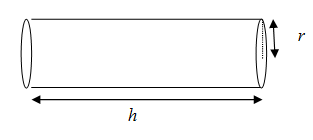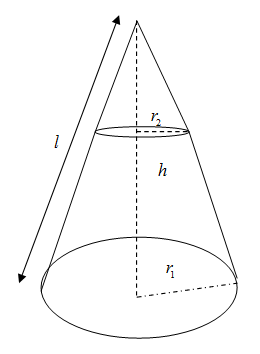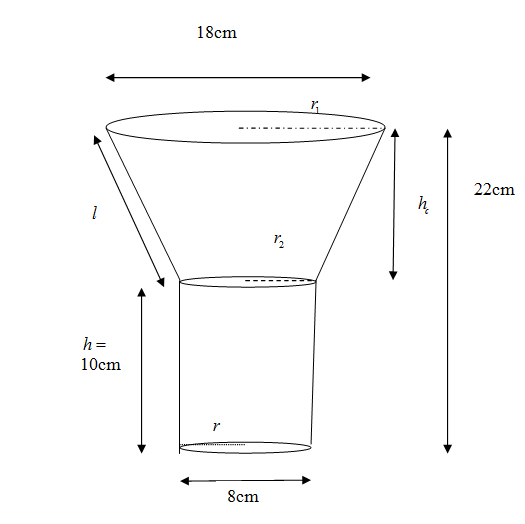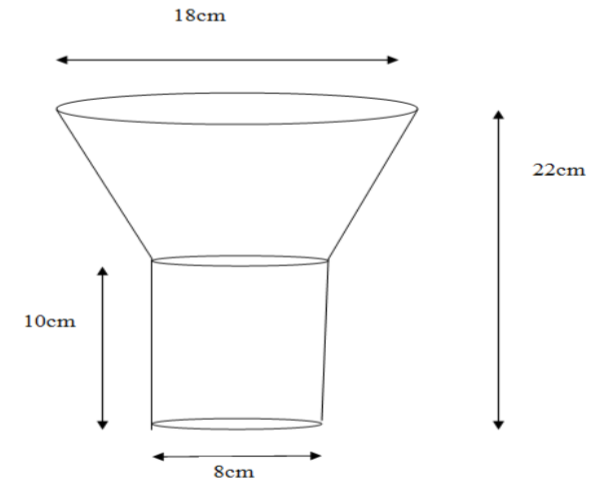
Answer
450.6k+ views
Hint: We see that the surface area required to make a tin sheet of funnel is the sum of curved surface area of the cylinder and frustum cone. We find curved surface area of the cylinder using the formula ${{A}_{1}}=2\pi rh$ and the curved surface area of the cylinder of frustum cone using the formula ${{A}_{2}}=\pi \left( {{r}_{1}}+{{r}_{2}} \right)l$ . We add ${{A}_{1}},{{A}_{2}}$ to get the answer. \[\]
Complete step by step answer:

We know that the curved surface area of cylinder with radius at the edge $r$ and length $h$ is given by ${{A}_{1}}=2\pi rh$\[\]

A frustum cone is lower part of a cone when a plane parallel to the base cuts the upper part We also know the curved surface area of frustum cone with radius of the base ${{r}_{1}}$, radius of the circular upper section ${{r}_{2}}$ and the slant height $l$ is given by ${{A}_{2}}=\pi \left( {{r}_{1}}+{{r}_{2}} \right)l$ . We can find slant height from ${{r}_{1}},{{r}_{2}},h$ by the formula $l=\sqrt{{{h}^{2}}+{{\left( {{r}_{1}}-{{r}_{2}} \right)}^{2}}}$\[\]

The oil funnel made of tin sheet has its upper part as frustum cone and lower part as a cylinder. We are asked to find the area required to make the tin sheet. We see that the o that is funnel is hollow inside. So we do not tin sheet for the base area and only need for the curved surface area. \[\]
It is given that the diameter of the cylinder at the lower part of the funnel is 8cm. So the radius of the lower base is $r=\dfrac{8}{2}=4cm$. The height is given $h=10$cm. So the curved surface area of the cylinder is ${{A}_{1}}=2\pi \left( 4 \right)\left( 10 \right)=80\pi \text{c}{{\text{m}}^{\text{2}}}$\[\]
We see in the upper part that a frustum cone has height which is the difference of height of the funnel and the height of the cylinder. So height of frustum cone is ${{h}_{c}}=22$cm, the diameter of the upper base 18cm, so its radius is ${{r}_{1}}=\dfrac{18}{2}=9$cm. The radius of the lower base is the same as the radius of the cylinder ${{r}_{2}}=4$cm. So the slant height is
\[\begin{align}
& l=\sqrt{{{h}^{2}}+{{\left( {{r}_{1}}-{{r}_{2}} \right)}^{2}}} \\
& =\sqrt{{{12}^{2}}+{{\left( 9-4 \right)}^{2}}} \\
& =\sqrt{144+25} \\
& =13 \\
\end{align}\]
So the curved surface area of the frustum cone is ${{A}_{2}}=\pi \left( {{r}_{1}}+{{r}_{2}} \right)l=\pi \left( 9+4 \right)13=169\pi \text{c}{{\text{m}}^{\text{2}}}$
So the total surface area of funnel is sum of curved surface area of the cylinder and cone,
\[{{A}_{1}}+{{A}_{2}}=80\pi +169\pi =249\pi =249\times 3.14=781.6\text{c}{{\text{m}}^{\text{2}}}\]
Note: The important thing we notice here is we do not add the base area because the inside of a funnel is hollow. The total surface are of a cylinder is $2\left( \pi rh+\pi {{r}^{2}} \right)$ and the total surface area of frustum cone is $\pi \left( {{r}_{1}}+{{r}_{2}} \right)l+\pi {{r}_{1}}+\pi {{r}_{2}}$.
Complete step by step answer:

We know that the curved surface area of cylinder with radius at the edge $r$ and length $h$ is given by ${{A}_{1}}=2\pi rh$\[\]

A frustum cone is lower part of a cone when a plane parallel to the base cuts the upper part We also know the curved surface area of frustum cone with radius of the base ${{r}_{1}}$, radius of the circular upper section ${{r}_{2}}$ and the slant height $l$ is given by ${{A}_{2}}=\pi \left( {{r}_{1}}+{{r}_{2}} \right)l$ . We can find slant height from ${{r}_{1}},{{r}_{2}},h$ by the formula $l=\sqrt{{{h}^{2}}+{{\left( {{r}_{1}}-{{r}_{2}} \right)}^{2}}}$\[\]

The oil funnel made of tin sheet has its upper part as frustum cone and lower part as a cylinder. We are asked to find the area required to make the tin sheet. We see that the o that is funnel is hollow inside. So we do not tin sheet for the base area and only need for the curved surface area. \[\]
It is given that the diameter of the cylinder at the lower part of the funnel is 8cm. So the radius of the lower base is $r=\dfrac{8}{2}=4cm$. The height is given $h=10$cm. So the curved surface area of the cylinder is ${{A}_{1}}=2\pi \left( 4 \right)\left( 10 \right)=80\pi \text{c}{{\text{m}}^{\text{2}}}$\[\]
We see in the upper part that a frustum cone has height which is the difference of height of the funnel and the height of the cylinder. So height of frustum cone is ${{h}_{c}}=22$cm, the diameter of the upper base 18cm, so its radius is ${{r}_{1}}=\dfrac{18}{2}=9$cm. The radius of the lower base is the same as the radius of the cylinder ${{r}_{2}}=4$cm. So the slant height is
\[\begin{align}
& l=\sqrt{{{h}^{2}}+{{\left( {{r}_{1}}-{{r}_{2}} \right)}^{2}}} \\
& =\sqrt{{{12}^{2}}+{{\left( 9-4 \right)}^{2}}} \\
& =\sqrt{144+25} \\
& =13 \\
\end{align}\]
So the curved surface area of the frustum cone is ${{A}_{2}}=\pi \left( {{r}_{1}}+{{r}_{2}} \right)l=\pi \left( 9+4 \right)13=169\pi \text{c}{{\text{m}}^{\text{2}}}$
So the total surface area of funnel is sum of curved surface area of the cylinder and cone,
\[{{A}_{1}}+{{A}_{2}}=80\pi +169\pi =249\pi =249\times 3.14=781.6\text{c}{{\text{m}}^{\text{2}}}\]
Note: The important thing we notice here is we do not add the base area because the inside of a funnel is hollow. The total surface are of a cylinder is $2\left( \pi rh+\pi {{r}^{2}} \right)$ and the total surface area of frustum cone is $\pi \left( {{r}_{1}}+{{r}_{2}} \right)l+\pi {{r}_{1}}+\pi {{r}_{2}}$.
Recently Updated Pages
what is the correct chronological order of the following class 10 social science CBSE

Which of the following was not the actual cause for class 10 social science CBSE

Which of the following statements is not correct A class 10 social science CBSE

Which of the following leaders was not present in the class 10 social science CBSE

Garampani Sanctuary is located at A Diphu Assam B Gangtok class 10 social science CBSE

Which one of the following places is not covered by class 10 social science CBSE

Trending doubts
Which are the Top 10 Largest Countries of the World?

What percentage of the solar systems mass is found class 8 physics CBSE

Fill the blanks with the suitable prepositions 1 The class 9 english CBSE

The Equation xxx + 2 is Satisfied when x is Equal to Class 10 Maths

How do you graph the function fx 4x class 9 maths CBSE

Give 10 examples for herbs , shrubs , climbers , creepers

Difference Between Plant Cell and Animal Cell

Why is there a time difference of about 5 hours between class 10 social science CBSE

Difference between Prokaryotic cell and Eukaryotic class 11 biology CBSE




